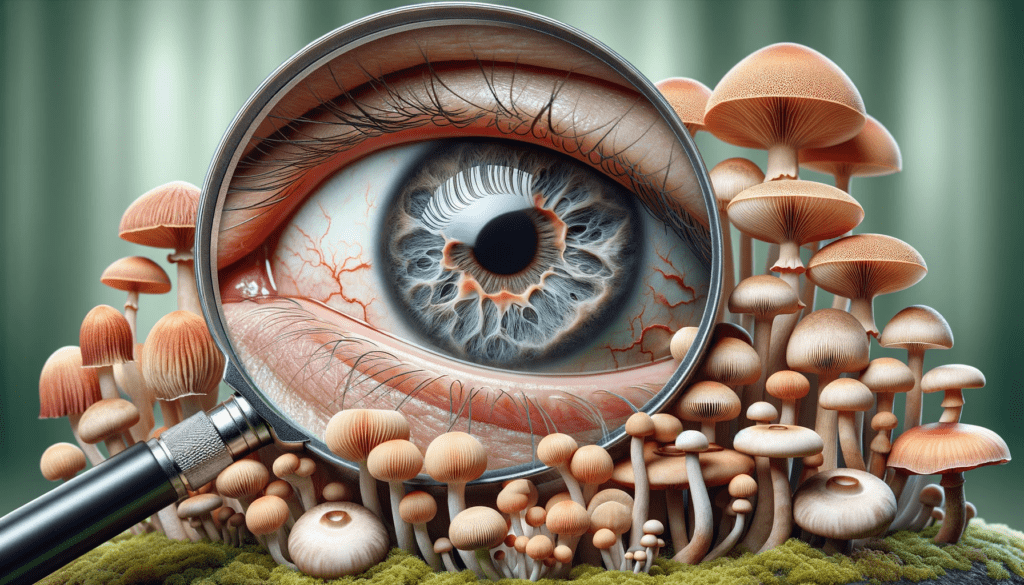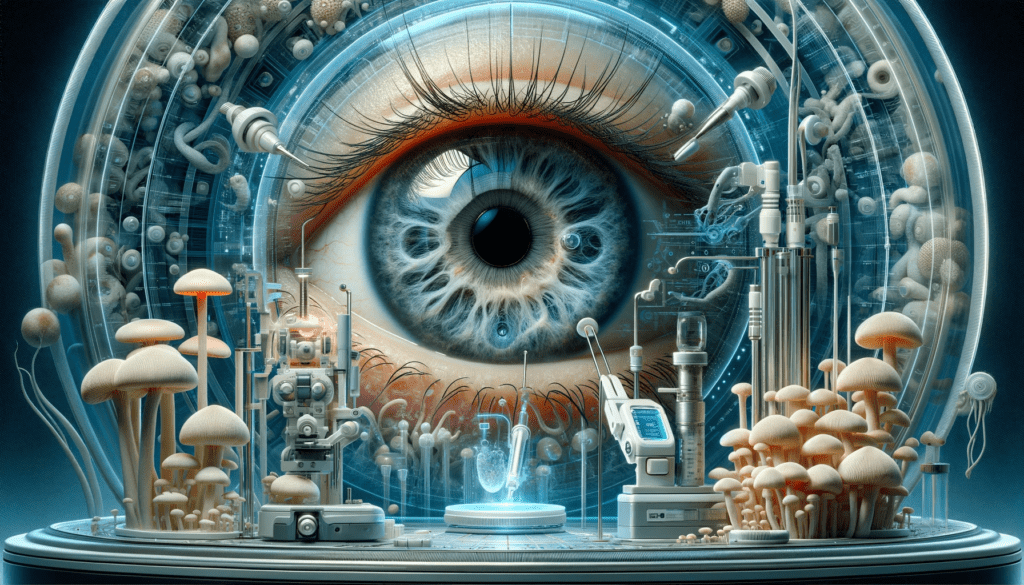Vision represents one of our most precious senses. Yet deteriorating eyesight afflicts over 2.2 billion globally. Common age-related eye troubles like glaucoma, cataracts, and macular degeneration erode the quality of life while increasing risks for injury and death. Thankfully, certain mushrooms demonstrate protective, restorative potential for preserving our eye health over the long run.
Vision fuels life’s every activity, enabling safe navigation, threat detection, facial recognition, reading, driving, and beyond. Yet deteriorating eyesight burdens over 2.2 billion people globally, with projections expecting 50% of the world’s population to endure impairing vision troubles by 2050. Common ocular conditions like glaucoma, cataracts, macular degeneration, and dry eye erode the quality of life while increasing the risks of injury.
Thankfully, research reveals certain mushrooms hold protective, restorative potential for preserving precious sight. Bioactive fungi both slow the progression of degenerative optical diseases and encourage ocular tissue regeneration when damage already exists.
From blocking cataracts to stimulating optic nerve repair after glaucomatous injury, medicinal mushrooms emerge as promising natural allies supporting eye health over the long run. Their unique metabolites shield delicate photoreceptors against blue light damage from our increasingly digital lifestyles as well. Even obscure mycelium extracts display remarkable healing activities against macular degeneration in initial trials.
Beyond supplemental applications, mushrooms’ ancient underground wisdom networks may adjust societal vision more clearly too. Join us as we explore eye-opening fungal allies for community care.
Glaucoma and Mushroom Benefits

Glaucoma describes a group of progressive optic neuropathies damaging the optic nerve connecting the eye to the brain resulting in vision loss and eventual blindness. While no cure exists yet for glaucoma, medicinal mushrooms show therapeutic promise supporting other standard treatments.
Test tube investigations reveal lion’s mane extract safeguards retinal cells and neural pathways involved in relaying visual information to the brain from free radical damage. Nerve growth factor peptides abundant in lion’s mane also encourage regeneration of injured optic nerves over time.
Reishi and cordyceps mushrooms similarly protect retinal pigment cells essential for sharp sight against oxidative stress. Antioxidant-rich turkey tail, maitake, and agaricus subrufescens make additional glaucoma-fighting allies by quenching inflammation and preventing tissue degeneration over the long haul. Always discuss adding mushrooms to supplement regimens with your eye doctor.
Hope for Dry Eye Health Sufferers
Chronic dry eye disease leaves over 20 million Americans frustratingly fumbling for eye drops to lubricate irritated eyes when blinking fails to evenly coat surfaces. The condition worsens with age as oil glands atrophy, exacerbated by wind, screens, medications, and environmental factors. Tear supplement formulas now harness mushrooms’ nourishing abilities to better manage this burdensome affliction.
Studies demonstrate how extracts from Agaricus blazei, cordyceps and reishi mushrooms mixed into eye drops replenish mucins – the slippery protective coating keeping eyes comfortably moisturized. Beyond just temporary relief, mushrooms’ anti-inflammatory, collagen-preserving, and antioxidant actions treat root causes of dry, irritated eyes at the cellular level for lasting comfort.
Mushrooms vs. Cataracts

Ranking as the world’s leading cause of blindness by age 80, cataracts develop as proteins accumulate in the lens of the eye obstructing light and distorting incoming images. Corrective surgery effectively removes clouded lenses, but mushrooms may prevent cataracts from forming in the first place.
Multiple animal model experiments reveal mushroom extracts defend lens transparency by blocking the accumulation of sorbitol in eye tissues – a culprit sugar alcohol behind cataract development. Cordyceps, reishi, and the Brazilian blazei mushroom boost aldose reductase activity which breaks down troublesome sorbitol into harmless fructose and prevents visualization.
Further investigations show how selenium-rich mushrooms like maitake, shiitake, and Brazil species protect eye proteins called crystallins which keep lenses clear and flexible. The optically-advantageous antioxidants lutein and zeaxanthin found abundantly in shiitake mushrooms also filter damaging UV rays preventing oxidative damage underpinning most age-related eye diseases.
Visionary Fungi Combat Blue Light Damage
While antioxidant vitamins like A, C, and E benefit eye wellness, they don’t shield against the shorter wavelength of visible blue light from digital devices and LED lighting increasingly linked to macular degeneration. Thankfully, novel metabolites produced in mushrooms like ergothioneine excel at absorbing high-energy blue light preventing injury.
Ergothioneine occurs at a higher concentration in mushrooms than in any other food! Royalties like the king oyster mushroom contain up to 2 milligrams per gram ergo alongside other protective antioxidants like glutathione and selenium for unparalleled preservation of photoreceptor cells vulnerable in the central retinal matrix.
Feeding our eyes mushrooms daily proves highly visionary fuel against relentless exposure to artificial light sources. But don’t stop at king oysters…lion’s mane, maitake, and cordyceps also pack eye-saving ergothioneine to stock up on!
The Future is Fungi: Mycoprotein for Macular Care

While antioxidant benefits certainly boost mushrooms’ eye health potentials, perhaps their most promising application comes through an unusual mycoprotein source called microtechnology. Derived from mushroom root-like mycelium, this novel ingredient called Qualia shows early promise in combatting age-related macular degeneration.
When added to human cell cultures, mycoprotein-protected retinal pigment epithelial cells are indispensable for vision against death while increasing the activity of key antioxidant and detoxification enzymes. Mycotechnology also lowered inflammation, insulin resistance, and free radical damage promoting molecular regeneration.
Human trials are still forthcoming, but researchers feel hopeful this mycelium extract can provide therapeutic protection and repair to stop advancing macular degeneration – the Western world’s primary source of blindness in the elderly.
Mycelium Medicine
Given mushroom fruiting bodies’ proven protective prowess for eye structures through animal models and cell studies thus far, perhaps their hidden mycelial networks hold untold healing secrets still. After all, we’ve merely scratched the surface of kingdom fungi’s mutualistic mysteries developed with plant partners underground for eons!
What other fungal wisdom remains unearthed while more people lose vision daily? Bioprospecting efforts must salvage fast-disappearing forest fungal diversity before these evolutionary gifts disappear. Mycologists estimate over 90% of Earth’s mushroom species remain unclassified, though most natural habitats face threats from development and climate change.
Indigenous cultures understood mushroom medicine as sacred earth medicine – the fruiting signals of vast sentient networks holding up the forest. And just as mycelial threads weave around root systems in soil symbiosis, perhaps mushrooms naturally interface with our nervous system pathways in helpful biofeedback.
If we align once again with time-tested mycological allies as guides, fungi offer templates for repairing frayed lifelines in danger of disconnect whether neural pathways damaged by neurodegeneration or reciprocal relationships damaged by exploitation. Perhaps mushroom medicine awakens sensory healing through heart work first.
Seeing Ourselves through Mushroom Eyes
Mushrooms represent master chemists converting decaying forestry elixirs into medicinal foods and bioremediating compounds. Yet we forget fungi perceive realities – have their ways of sensing, processing, and responding. Mushrooms grow extensive below-ground webs fluidly interfacing between organisms and ecosystem patterns in feats of collective brilliance.
What insights emerge when we regard mushrooming through their fungal point of view – one oriented toward auxiliary nutrition, collaborative repair, and communal renewal? Rather than imposing our aims, mushrooms model mutual thriving through self-organized cooperation and empathetic exchange.
Seeing our human communities through mushroom eyes, do we nourish each other in a layered symbiosis where everyone gets fed? Do we recalibrate inclusive care as the central metric of success? Perhaps mushrooms as ancient seers wise beyond human timescales can adjust our evolutionary trajectory more clearly.
The greatest visionaries often prove the least acknowledged until perspective shifts recognize them as trailblazers. Global conditions call to finally uplift mycelial consciousness so long supporting terrestrial wellbeing selflessly from below. May mushroom wisdom help us find our way through endangered habitats – and endangered hearts – we all call home.
Our sight represents a precious gift easing navigation through the world. Yet a global rise in glaucoma, cataracts, macular degeneration, and dry eye threatens this vital sense for millions. Thankfully, mushrooms emerge as promising natural allies supporting eye health and visual acuity over the long run.
From blocking cataract formation to stimulating optic nerve regeneration, mushrooms reveal therapeutic potential for reversing common age-related eye troubles. Antioxidants like ergothioneine uniquely found in fungi guard delicate photoreceptor cells against blue light damage from our increasingly digital lifestyles.
Early research suggests that mycelium-derived compounds may even curb macular degeneration. Beyond supplement applications, mushrooms’ self-organized cooperation underground holds wisdom for more communities crafting reciprocal systems of nourishing care.
Regarding society’s faltering vision through mushroom eyes, what collaborative patterns and untapped gifts surface? By uplifting the consciousness of our ancient fungal allies underfoot, perhaps mycelium offers a perspective for repairing connectivity and mutual thriving so all bodies flourish in balance again. Our collective sight depends on it.



